Display Aircraft for 2018

|
|||
  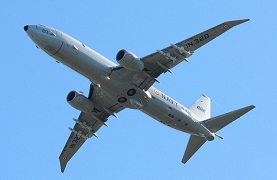 The P-8A Poseidon, the U.S. Navy’s newest maritime, patrol and reconnaissance aircraft is a multi-mission capable replacement aircraft for the legacy P-3C Orion. The P-8A is designed to improve an operator’s ability to conduct anti-submarine warfare; anti-surface warfare; and intelligence, surveillance, and reconnaissance missions. Additionally, it’s combat-capable and provides warfighters added protection. The P-8A operates with a smaller crew, yet it also delivers an extended global reach, greater payload capacity, higher operating altitude, open-systems architecture and significant growth potential. Wing Span: 124 ft. Max takeoff weight: 189,200 lbs. Max speed: 564 mph. Open for tours.
|
|||
|
|||
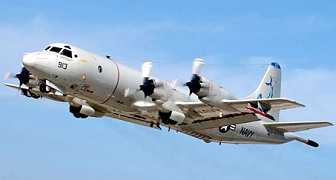 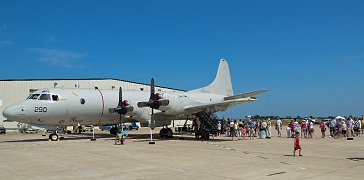  The Lockheed P-3 Orion is a four-engine turboprop anti-submarine and maritime surveillance aircraft developed for the United States Navy and introduced in the 1960s. Lockheed based it on the L-188 Electra commercial airliner. The aircraft is easily distinguished from the Electra by its distinctive tail stinger or "MAD Boom", used for the magnetic detection of submarines. Over the years, the aircraft has seen numerous design advancements, most notably to its electronics packages. The P-3 Orion is still in use by numerous navies and air forces around the world, primarily for maritime patrol, reconnaissance, anti-surface warfare and anti-submarine warfare. A total of 734 P-3s have been built, and in 2012, it joined the handful of military aircraft that have served 50 years of continuous use by the United States military. This one comes to us from the “Pro’s Nest” Patrol Squadron VP-30, NAS Jacksonville, FL. Max takeoff weight: 142,000 lbs. Max speed: 473 mph. Open for tours.
|
|||
|
|||
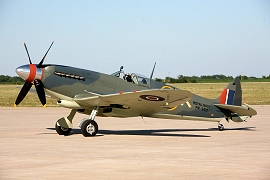  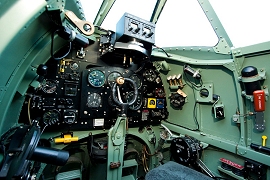  This airplane is one of only four known Seafire Mk. XVs to exist in the world and it may be the only flying Supermarine Seafire Mk. XV in the world. Dr. Wes Stricker's immaculate Supermarine Seafire Mk. XV (also known as the "hooked Spitfire") is based in Columbia, MO, was restored by Jim Cooper, and made its first post-restoration flight in 2010. The Supermarine Seafire was a naval version of the Supermarine Spitfire specially adapted for operation from aircraft carriers. The Seafire's mission was primarily as a short range interceptor. Wing span: 36ft 10in. Max takeoff weight: 7,640 lb. Max speed: 359 mph. Power: 1,850 hp.
|
|||
|
|||
 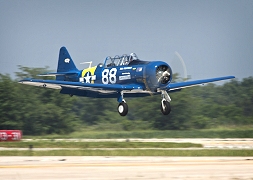   "Radial Velocity" is a WWII T-6 trainer that has raced the past five years in the fastest motor sport on earth - The Reno Air Races. Owned and flown by John Lohmar of St. Louis, MO, based at Creve Coeur Airport, Radial Velocity missed 2nd place by only 1 second in the 2013 Reno Races. The North American T-6 Texan was a single-engine advanced trainer aircraft used to train pilots of the United States Army Air Forces, United States Navy, Royal Air Force and other air forces of the British Commonwealth during World War II and into the 1950s. The T-6 is known by a variety of designations depending on the model and operating air force. The USAAC designated it as the AT-6, the United States Navy the SNJ, and British Commonwealth air forces, the Harvard, the name it is best known by outside of the United States. It remains a popular warbird aircraft. Wingspan: 42 ft. Loaded weight: 5,617 lb. Max speed: 222 mph.
|
|||
|
|||
 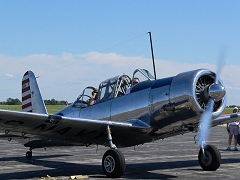  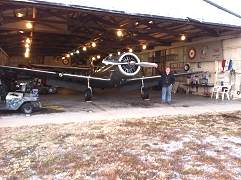 The Vultee BT-13 Valiant was an American World War II-era basic trainer aircraft built by Vultee Aircraft for the United States Army Air Corps, and later US Army Air Forces. The Vultee BT-13 was the basic trainer flown by most American pilots during World War II. It was the second phase of the three phase training program for pilots. After primary training in PT-13, PT-17, or PT-19 trainers, the student pilot moved to the more complex Vultee for continued flight training. The BT-13 had a more powerful engine and was faster and heavier than the primary trainer. It required the student pilot to use two way radio communications with the ground and to operate landing flaps and a two-position Hamilton Standard controllable-pitch propeller. It did not, however, have retractable landing gear or a hydraulic system. The flaps were operated by a crank-and-cable system. Its pilots nicknamed it the "Vultee Vibrator." This BT-13 is owned and flown by Jay Williams from Marceline MO. Wingspan: 42 ft. Max weight: 4,496 lb. Max speed: 180 mph. Power: 450 hp.
|
|||
|
|||
 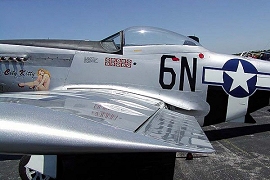 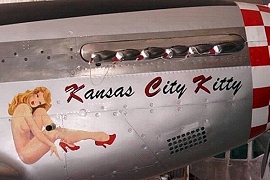 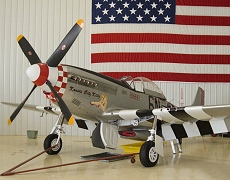 "Kansas City Kitty" is a beautiful example of a 1945 North American P-51D Mustang long-range fighter and escort. Initially P-51's were built with an Allison engine and the fighter handled well at low altitudes but exhibited lackluster performance over 15,000 feet. Rolls-Royce was invited to review the aircraft, and the result was legendary: with the Rolls-Royce 61 engine, the fighter could reach 433 mph at 20,000 feet, with an absolute ceiling of 40,300 feet. This combination catapulted the Mustang to near-mythic status, which continues today. Kansas City Kitty is owned and flown by Dr. Wes Stricker based in Columbia, MO. Loaded weight: 9,200 lb. Max speed: 437 mph.
|
|||
|
|||
  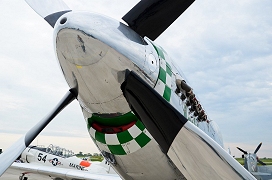  "Archie" is another beautiful example of a North American P-51 Mustang fighter, owned by "Captain" Lee Maples, Vichy, MO. At the start of Korean War, the Mustang was the main fighter of the United Nations until jet fighters such as the F-86 took over this role; the Mustang then became a specialized fighter-bomber. Despite the advent of jet fighters, the Mustang remained in service with some air forces until the early 1980s. After World War II and the Korean War, many Mustangs were converted for civilian use, especially air racing.. Loaded weight: 9,200 lb. Max speed: 437 mph.
|
|||
|
|||
 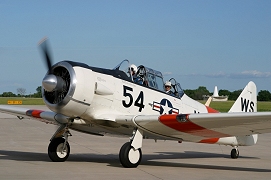 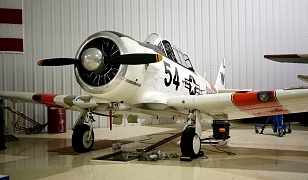 The North American Aviation T-6 Texan was a single-engine advanced trainer aircraft used to train pilots of the United States Army Air Forces , United States Navy , Royal Air Force and other air forces of the British Commonwealth during World War II and into the 1950s. Designed by North American Aviation , the T-6 is known by a variety of designations depending on the model and operating air force. The USAAC and USAAF designated it as the AT-6, the United States Navy the SNJ, and British Commonwealth air forces, the Harvard, the name it is best known by outside of the US. After 1962, US forces designated it the T-6. It remains a popular warbird aircraft used for airshow demonstrations and static displays. This T-6 is owned and flown by Dr. Wes Stricker based in Columbia, MO. Wingspan: 42 ft. Loaded weight: 5,617lb. Power: 600 hp. Maximum speed: 208 mph.
|
|||
|
|||
    The SIAI-Marchetti SM.1019 was an Italian STOL (Short TakeOff and Landing) liaison monoplane built by SIAI-Marchetti for the Italian Army and based on the O-1 Bird Dog. To meet an Italian Army requirement for a short take-off liaison aircraft, SIAI-Marchetti modified the design of the Cessna 305A/O-1 Bird Dog with a new turboprop engine and a revised tail unit. The prototype first flew on 24 May 1969 powered by a 317hp (236kW) Allison 250-B15C turboprop engine. It was evaluated against the Aermacchi AM.3 and was successful and won a production order for 80 aircraft. This SIAI-Marchetti SM.1019 is owned and flown by Dr. Wes Stricker based in Columbia, MO. Wingspan: 36 ft. Gross Weight: 3,196 lbs. Power: 400 hp (turboprop). Maximum Speed: 177 mph.
|
|||
|
|||
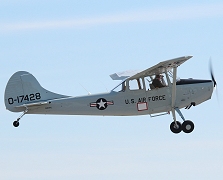  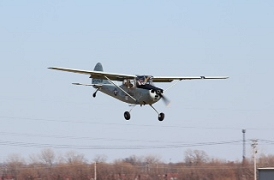 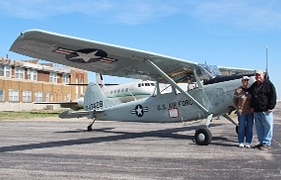 The Cessna L-19/O-1 Bird Dog was a liaison and observation aircraft. It was the first all-metal fixed-wing aircraft ordered by the US Army after the US Air Force separated into it's own branch in 1947. The L-19 received the name "Bird Dog" as a result of a contest held with Cessna employees to name the aircraft. The winning entry was chosen because the role of the army's new aircraft was to find the enemy and orbit overhead until artillery (or attack aircraft) could be brought to bear on the enemy. While flying low and close to the battlefield, the pilot would observe the exploding shells and adjust the fire via his radios, in the manner of a bird dog (gun dog) used by game hunters. This particular plane came off the Cessna assembly line at Wichita KS in 1951. The U. S. Army flew it until 1962 when it was sent to the Thai Army under a lease agreement. In 2009 it was declared surplus by the U.S.Army and scrapped in Thailand. In 2013 it was imported to the U.S. The plane was restored to its present condition in 2016 and painted in the U.S. Air Force markings from the Vietnam era. This aircraft is owned and flown by John and Liz Schaefer of Waterloo, IL. Wingspan: 36'. Empty weight: 1,614 lbs. Max. takeoff weight: 2,430 lbs. Cruise speed: 104mph. Horsepower: 213 hp.
|
|||
|
|||
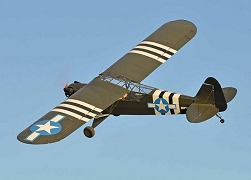 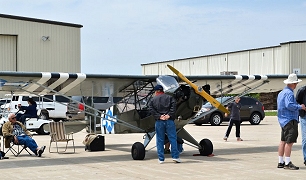   Piper L4 (O-59) "Grasshopper" Observation/Liaison aircraft (military version of the J3 Cub). The L4 was manufactured by Piper Aircraft for the U.S. Army Air Force for liaison and artillery spotter/director duties. It became one of the most popular of the light "Grasshopper" class of liaison aircraft and was also was heavily used for the initial phase of pilot training. This specific aircraft was built in 1945 as an L-4J in olive drab colors and delivered to the Army Air Corps. It was transferred from the military to a civilian registration in 1956, however it still displays it's military heritage in olive drab paint and D-Day invasion stripes. This aircraft is owned and flown by Mark Pierce of the Kansas City Dawn Patrol. Wingspan: 35' 3". Empty weight: 765 lbs. Max. takeoff weight: 1,220 lbs. Cruise speed: 75mph. Horsepower: 65 hp.
|
|||
|
|||
   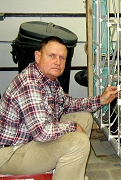 Introduced in 1916, the Nieuport 11 was an extremely successful French-built WW I fighter. It was flown by the French, British, and Russian armed forces. Dicks' is painted in the colors of the 1916 Lafayette Escadrille, the first planes ever flown by American pilots in an organized squadron in WWI. The screaming Sioux Indian head painted on the side of the fuselage adopted by the pilots of the Lafayette Escadrille was the logo from a box of Savage Arms .303 machine gun ammunition. The Lewis 303 drum-fed machine gun mounted on the top wing was there to shoot over the propeller’s arc because at that time, the allies did not have the technology to fire the machine gun through the propeller without hitting the spinning prop. This replica was plans built by aviation author Dick Starks in in conjunction Tom Glaeser's Nieuport in 1984. It is 7/8 scale and powered with a Volkswagon engine and based in Kansas City.
|
|||
|
|||
  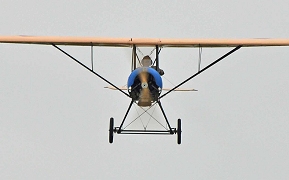  This Morane-Saulnier "L" is a scale replica of the first airplane to shoot down a Zeppelin in WW I. The Morane-Saulnier was one of the first successful fighter planes. It was built in both one- and two-seat configurations. It had a forward-facing machine gun that fired through the arc of the propeller, which was armored so as to deflect any shots that struck it. Overall, about 600 were built. Its success triggered a rapid aircraft cycle in several nations, which quickly rendered it obsolete. Interestingly, the first fighter-fighter victory occurred when a German Fokker shot down one of the two-seat versions of the L-series aircraft. This is an Airdrome Airplanes replica and was built and flown by Sharon Starks of Parkville, MO. This specific aircraft appeared in the movie Amelia. A story about Amelia Earhart.
|
|||
|
|||
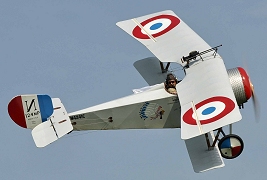 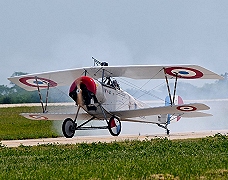 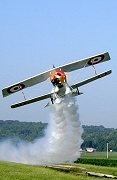  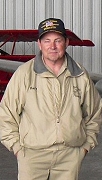 The Nieuport 16 was an improved version of the Nieuport 11 with a more powerful engine and the addition of a small headrest behind the cockpit. It was flown by the French, British, and Russian armed forces. This one is painted in the colors of the 1916 Lafayette Escadrille, the first planes ever flown by American pilots in an organized squadron in WWI. The Lewis 303 drum-fed machine gun mounted on the top wing was there to shoot over the propeller’s arc because at that time, the allies did not have the technology to fire the machine gun through the propeller without hitting the spinning prop. This Nieuport 16 replica was plans built by Mark Pierce 1986. Based in Kansas City. It is 7/8 scale and powered with a Volkswagon engine.
|
|||
|
|||
 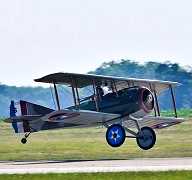 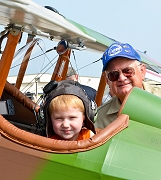  The Société Provisoire des Aéroplanes Deperdussin (SPAD) designed this aircraft as a WW I fighter. Appearing in 1916, it was first thought to be too heavy and unmaneuverable to be an effective fighter, but as pilots learned its strengths, it became one of the most capable fighters of the war, and one of the most-produced, with 8,472 built and orders for around 10,000 more cancelled at the Armistice. This beautiful replica was built and is flown by Marvin Berk from the Gardner Municipal Airport, home of the annual Gathering of Eagles.
|
|||
|
|||
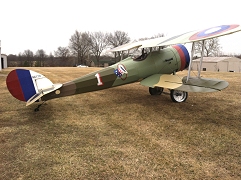 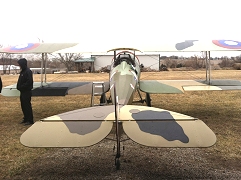  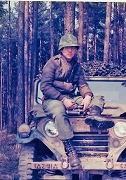 The Nieuport 28 was a French biplane fighter aircraft flown during World War I. Its principal claim to fame is that it was the first aircraft to see service with an American fighter squadron. It was designed to carry an up-to-date armament of twin synchronized machine guns, had a more powerful engine, and a new wing structure – for the first time a Nieuport biplane was fitted with conventional two spar wings, top and bottom, in place of the sesquiplane "v-strut" layout of earlier Nieuport types. The tail unit’s design closely followed that of the Nieuport 27, but the fuselage was much slimmer, in fact it was so narrow that the machine guns had to be offset to the left. This plane was built and is flown by Gary Knight and is based in Basehor Kansas. |
|||
|
|||
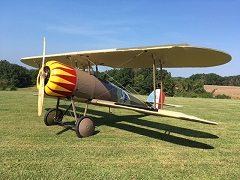    The Nieuport 28 was a French biplane fighter aircraft flown during World War I. Its principal claim to fame is that it was the first aircraft to see service with an American fighter squadron. It was designed to carry an up-to-date armament of twin synchronized machine guns, had a more powerful engine, and a new wing structure – for the first time a Nieuport biplane was fitted with conventional two spar wings, top and bottom, in place of the sesquiplane "v-strut" layout of earlier Nieuport types. The tail unit’s design closely followed that of the Nieuport 27, but the fuselage was much slimmer, in fact it was so narrow that the machine guns had to be offset to the left. This plane was built and owned by Salute's own Ken Hines, famous as the past "Voice of the Airshow".
|
|||
|
|||
  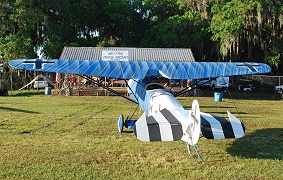 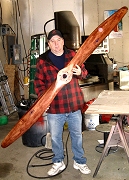 This is a replica of a the Fokker D.VIII German parasol-monoplane fighter aircraft built by Fokker-Flugzeugwerke in 1918. It was the last Fokker design to become operational with the Luftstreitkräfte, entering service in the last months of World War I. Dubbed the "Flying Razor" by Allied pilots, the D.VIII had the distinction of scoring the last aerial victory of the war. This replica was designed and built by Robert Baslee of Airdrome Aeroplanes located in Holden, MO. |
|||
|
|||
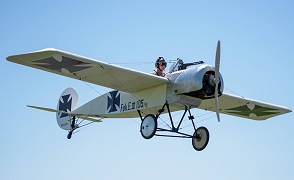 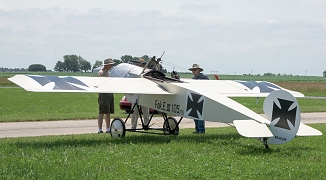 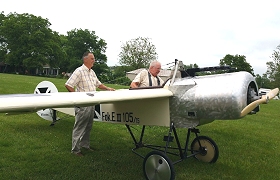 The Fokker Eindecker fighters were a series of German World War I monoplane single-seat fighter aircraft designed by Dutch engineer Anthony Fokker. Developed in April 1915, the first Eindecker ("Monoplane") was the first purpose-built German fighter aircraft and the first aircraft to be fitted with a synchronization gear, enabling the pilot to fire a machine gun through the arc of the propeller without striking the blades. The Eindecker gave the German Air Service a degree of air superiority from July 1915 until early 1916. This period, during which Allied aviators regarded their poorly armed aircraft as "Fokker Fodder", became known as the "Fokker Scourge". This is an Airdrome Airplanes replica and was built and flown by Carl Melin and Charlie Radford.
|
|||
|
|||
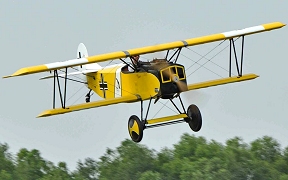    The Fokker D.VII was a German World War I fighter aircraft designed by Reinhold Platz of the Fokker-Flugzeugwerke. Germany produced around 3,300 D.VII aircraft in the summer and autumn of 1918. In service, the D.VII quickly proved itself to be a formidable aircraft. The plane was so good that is was said to make an average pilot good, a good pilot great and a great pilot invincible. The plane was so effective that the Armistice ending the war specifically required Germany to surrender all D.VIIs to the Allies at the conclusion of hostilities.[1] Surviving aircraft saw continued widespread service with many other countries in the years after World War I. The Fokker D-VII was still in production in 1929 and served in every European air force. This 87% scale replica was built and flown by Darryl Porter. |
|||
|
|||
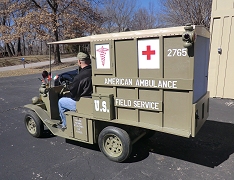 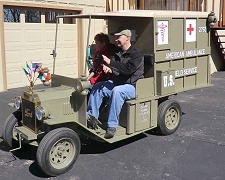    Early in WWI, horse-drawn carriages were used to transport the wounded but were quickly replaced by motor driven carriages. Some French and many American Ambulance Field Service (AAFS) ambulances were based on converted Ford Model T automobile chassis. American sponsored Ford Model Ts were sent over as a chassis and the passenger box was a kit strapped to the top for assembly in France. The Tin Lizzie quickly became a favorite of the drivers. Many of the same schools and towns that provided ambulance units also raised funds to provide an ambulance for their unit. The University of Missouri proudly put forth one of these units. All financed their own uniforms and transportation to France. The volunteer drivers of the AAFS were considered non-combatants and therefore could remain American citizens but were limited to medical transport. This ¾ scale replica is based on a 1915 Tin Lizzie and is built on a golf cart chassis by Dawn Patrol Members John O’Conner and the late Dave Laur. This year it will be transported and displayed at Salute by Steve Kenemore and Elaine Wheeler.
|
|||
|
|||
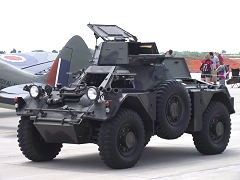 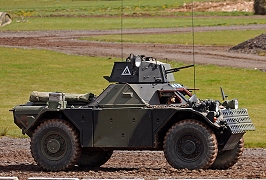 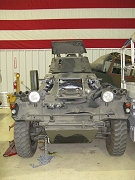 The Ferret armored car, also commonly called the Ferret Scout car, is a British armored fighting vehicle designed and built for reconnaissance purposes. The Ferret was produced between 1952 and 1971 by the UK company, Daimler. It was widely adopted by regiments in the British Army as well as Commonwealth countries throughout the period. This vehicle is owned by Dr. Wes Stricker and is based in Columbia, MO. Weight: 3.7 Tons Engine: Rolls Royce 130 hp Speed: 58 mph
|
|||